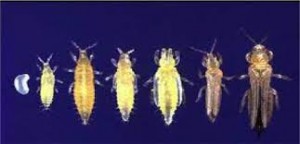I’m sure by now, everybody has found thrips and thrips damage everywhere. We are all aware what a serious pest thrips can be in our cotton and that it is a given, with the loss of Temik, that we are going to have to follow our current seed treatments with foliar sprays. I first spotted thrips damage about 3 weeks ago on 2-3 leaf cotton and immature thrips were present. The thrips will be located feeding, in terminal bud and unfurled leaves, on moisture from ruptured plant cells. The next true leaf to expand, after feeding site of thrips, will likely have significant damage. The finding of 2-3 thrips per plant is our treatment threshold. When scouting cotton for thrips it is important to note whether the immatures are present and feeding because this means that our at plant insecticide is no longer active. The best defense against thrips is a rapidly growing cotton plant. We hope to encourage this rapid growth with minimal herbicide injury on our young plant and warm temperatures. However, we can’t control thrips unless we use a combination of seed treatments, foliar sprays, and possible cultural practices. Cotton planted prior to May 10 and in conventional tillage is considered at high risk for thrips damage. The lower risk range for thrips damage includes cotton planted in reduced tillage during mid to late May. The later planted cotton is at slightly lower risk due to the cotton growing more rapidly with warmer temperatures. But, that doesn’t mean that the plant will not get thrips or that you will not have to make foliar insecticide applications. It is important to remember that thrips are a major economic concern until the 4 leaf stage. However, at the 4 leaf growth stage of cotton the plant is generally growing fast enough that thrips are no longer a major concern. When selecting insecticides for your foliar applications, keep in mind that pyrethroids are not an option for thrips control. The insecticide applied has to be a systemic product because we need the product to get inside the plant. When mixing thrip sprays with herbicides remember that this can increase injury to crop. I have listed thrips control product options below in order of safest to least safe to use in these tank mixes.
1. Orthene – Least likely to cause injury
2. Bidrin
3. Dimethoate – Worst on increased injury
There are no tank mix issues with thrips sprays and Glyphosate but you can see potential problems when mixing thrips insecticides with Glyphosate and post residual herbicides like Dual Magnum, Warrant, and Staple.

